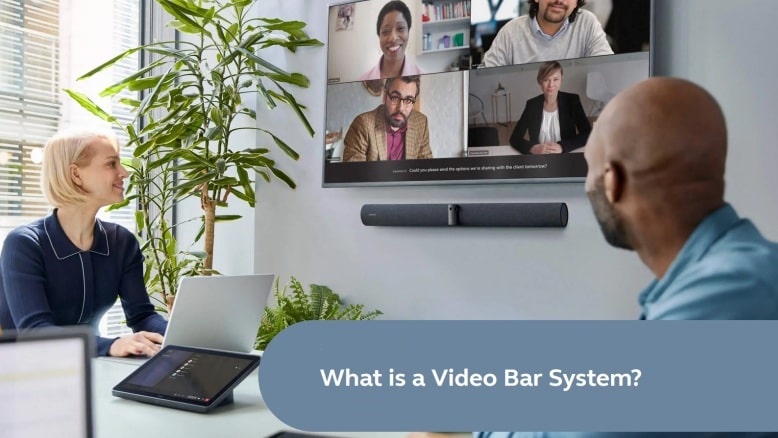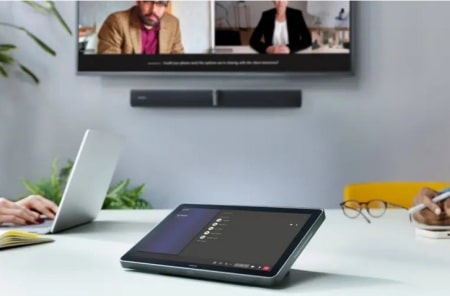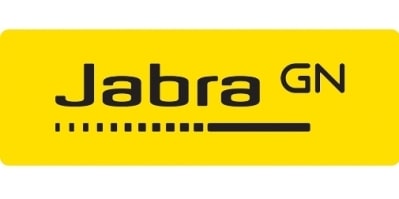Whether you’re in a small meeting room or a medium-sized conference room, a video bar system provides a high-quality audio and video experience, ensuring that every participant is seen and heard clearly. With hybrid meetings remaining at level in recent years according to the latest Hybrid Ways of Working Global Report, video bar systems are a crucial tool to ensure seamless meeting experiences and collaboration in these settings. However, still only 15% of employees say that all their office’s meeting rooms are equipped with video. Thus, we will delve into the features and benefits of video bar systems, provide tips for choosing the right one for you, and take a glimpse into the future of video bar systems.

The benefits of a Video Bar System
 Video bar systems offer a multitude of benefits for businesses and organizations looking to enhance their video conferencing experience. At its core, a video bar system is an integrated solution designed to enhance the experience of video meetings and collaboration. These all-in-one video solutions, such as the Jabra PanaCast 50 Video Bar System, incorporates a compact soundbar device that houses high-quality speakers, a microphone array, and a camera. Accompanied by a remote compute unit, these integrated video systems allow for a seamless meeting room experience which is easy to manage and eliminate the need to connect other devices, such as your laptop.
Video bar systems offer a multitude of benefits for businesses and organizations looking to enhance their video conferencing experience. At its core, a video bar system is an integrated solution designed to enhance the experience of video meetings and collaboration. These all-in-one video solutions, such as the Jabra PanaCast 50 Video Bar System, incorporates a compact soundbar device that houses high-quality speakers, a microphone array, and a camera. Accompanied by a remote compute unit, these integrated video systems allow for a seamless meeting room experience which is easy to manage and eliminate the need to connect other devices, such as your laptop.
These systems are specifically engineered to work optimally in small to medium-sized rooms, offering a simplified setup experience for users. Making it simple and plug&play for employees is key for adoption, as we know from our Hybrid Ways of Working 2023 Global Report that 1 in 3 employees are hesitant to use meeting rooms because they aren’t comfortable with the technology. With a video bar system, gone are the days of dealing with complex audio and video equipment setups and the hassle of multiple devices and cables.
Key Features of a Video Bar System
A typical video bar system comprises several key components that work together to deliver an immersive collaboration experience. Let’s take a closer look at each feature:
1. High-Quality Speakers: Video bar systems are equipped with speakers that provide powerful and high-fidelity audio. Most video bar systems offer several speakers in the video bar, like the PanaCast50 which has an array of four powerful speakers in a zero-vibration stereo setup. And with 64% of employees saying that seeing and hearing their colleagues makes it easier to trust them, high-quality sound is crucial for inclusion and seamless collaboration. Whether you’re listening to a presentation or engaging in a group discussion, the speakers in a video bar system deliver exceptional sound quality, ensuring that every word is heard with clarity – for both in-person and remote participants.
2. Microphone Array: These systems utilize an array of microphones strategically placed to capture voices from different directions, ensuring that everyone is heard clearly. Video bar systems, such as Jabra’s PanaCast 50 Video Bar System, are equipped with a number of advanced microphones that capture sound from multiple directions while removing background noise, enhancing the audio pickup range and ensuring that every participant’s voice is heard loud and clear.
3. Camera: The built-in camera in a video bar system delivers high-definition video, enabling participants to see each other clearly. Some video bar systems also offer pan, tilt, and zoom functionality, allowing you to adjust the camera angle and focus on specific participants or areas of interest. According to our latest Hybrid Ways of Working Global Report, 59% of employees say that working with colleagues in person or on video energizes them. A wide field of view camera like the 180° field of view multi-camera array in the PanaCast 50 enables just that and ensures everyone is seen and included in the meeting.
4. Remote Control: One of the standout features of the video bar system is its ability to simplify video meeting management. Equipped with a control unit placed in the meeting room, it not only eliminate the need for connecting to the video bar with a computer and the hassle with cables, users can easily adjust camera angles, zoom levels, and audio settings with just a few presses of a button.
How to Choose the Right Video Bar System
 Take the time to understand your specific meeting room and collaboration needs. Evaluate the features and functionalities of different video bar systems, and choose one that aligns closely with your requirements. Additionally, consider any unique demands or preferences your organization may have regarding interoperability, security, or collaboration tools certifications such as Microsoft Teams or Zoom Rooms. Key factors to consider:
Take the time to understand your specific meeting room and collaboration needs. Evaluate the features and functionalities of different video bar systems, and choose one that aligns closely with your requirements. Additionally, consider any unique demands or preferences your organization may have regarding interoperability, security, or collaboration tools certifications such as Microsoft Teams or Zoom Rooms. Key factors to consider:
– Room Size and Layout: Assess the size of your meeting space to determine whether the camera maximizes field of view and the layout to ensure a clear line of sight to each participant.
– Audio Quality: Look for systems with advanced audio processing technologies that deliver crystal-clear sound and ensure each participant, no matter how far back in the meeting room, can hear and be heard.
– Compatibility: Ensure the video bar system is compatible with your existing devices and collaboration platforms. Choosing a video bar system certified for your choice of collaboration platform will improve the experience and ensure it stays up-to-date. Systems as the PanaCast 50 Video Bar System come with certifications for platforms like Microsoft Rooms and Zoom Rooms.
– Usability: Consider the ease of setup, intuitive controls, and user-friendly interfaces for a hassle-free experience and to ensure your employees can get familiar with the technology. In the Hybrid Ways of Working 2023 Global Report, you’ll find tips on how to make employees comfortable with the technology.
– Future-proofing: As the collaboration category continues to evolve, it’s relevant to consider a video bar system that is future-ready. Choosing a video bar system with AI and next-level software can provide on-going updates to your device and ensure you are future-proof with the newest technology – as well as ensure you the highest level of security.
The Future of Video Bar Systems
 The rapid advancements in collaboration technology continue to shape the future of video bar systems. Some of the notable trends include:
The rapid advancements in collaboration technology continue to shape the future of video bar systems. Some of the notable trends include:
– Artificial Intelligence (AI) Integration: AI-powered features, such as voice command recognition and intelligent camera framing, enhance user experience and automate certain aspects of video conferencing. Some video bar systems already offer AI-powered features, one of them being the PanaCast 50 which is powered by Microsoft IntelliFrame offering multiple video streams, face and voice recognition to revolutionize meeting experiences.
– Intuitive User Interfaces: Video bar systems are incorporating user-friendly interfaces that simplify setup, operation, and customization for a seamless user experience.
– Enhanced Security Features: As data privacy and security become increasingly vital, video bar systems are implementing robust security measures, such as encryption and secure authentication protocols.
Time to invest in a Video Bar System?
Video bar systems are revolutionizing the way we take hybrid meetings and collaborate. With their integrated audio and video capabilities, comprehensive features, ease of use, and ability to enhance virtual meetings and remote work, these systems offer a seamless and immersive collaboration experience. By understanding the basics, exploring key features, and considering key factors when choosing a video bar system, you can make an informed decision that aligns with your collaboration needs. So, next time you’re upgrading your meeting rooms, consider the benefits of an all-in-one video bar system.
![]()
 Jabra is a world leading brand in audio, video, and collaboration solutions – engineered to empower consumers and businesses. Proudly part of the GN Group, we are committed to bringing people closer to one another or to whatever is important to them. Jabra engineering excellence leads the way, building on 150 years of pioneering work within GN. This allows us to create integrated tools for contact centers, offices, and collaboration to help professionals work more productively from anywhere; and true wireless headphones and earbuds that let consumers better enjoy calls, music, and media.
Jabra is a world leading brand in audio, video, and collaboration solutions – engineered to empower consumers and businesses. Proudly part of the GN Group, we are committed to bringing people closer to one another or to whatever is important to them. Jabra engineering excellence leads the way, building on 150 years of pioneering work within GN. This allows us to create integrated tools for contact centers, offices, and collaboration to help professionals work more productively from anywhere; and true wireless headphones and earbuds that let consumers better enjoy calls, music, and media.
For additional information on Jabra view their Company Profile



